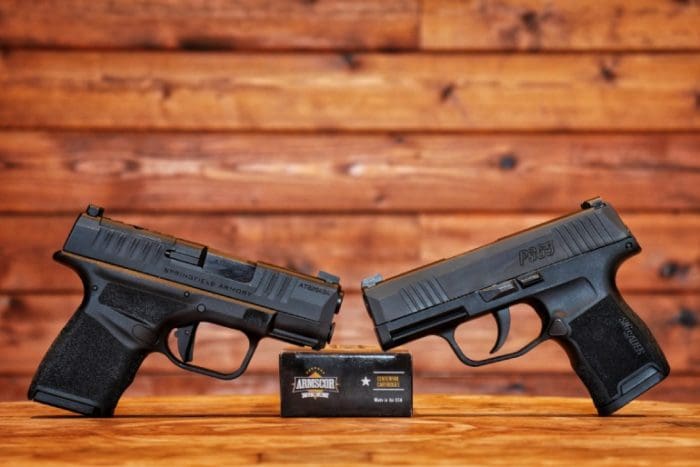Holding 11+1 rounds in its micro-compact magazine, it’s no mystery that the Springfield Armory Hellcat, reviewed by Dan here, has its sights set squarely on the famously standard-setting 10+1-round SIG Sauer P365 (reviewed by John Boch here and followed up by me here). Even though SIG wasn’t the first to shoehorn double-digit rounds of 9×19 into a “mouse gun” — heck, the Kel-Tec P-11 came out in 1995, has always held 10+1, and is the same or smaller than the P365 in length, width, and height — they sure enjoy the credit for it.
And P365 sales have been good. Extremely good.
A highly abbreviated version of my SIG SAUER P365 review would be: it’s teeny and easy to carry, holds 10+1 rounds in its flush mag, has a great trigger, great sights, has been 100% reliable with every possible type of ammo, and typically makes me look like a better shooter than I really am because it just shoots so freaking well for a micro-compact.
Somehow the backstrap on the Springfield ends up longer than on the SIG but the frontstrap ends up shorter. Again, in practice I didn’t find an advantage to one over the other. Possibly one of the two will print more at a certain angle or when carried in a certain location and the other wouldn’t. But we’re talking really small differences here and any advantage could easily be reversed in a different location at a different angle.
Not helping matters is the fact that the Hellcat has a stiffer recoil spring. Not hugely stiffer, but it’s very clearly noticeable. So it takes a little more force to rack the Hellcat’s slide and it has some of the least effective slide serrations going.
While I realize that, in the photo above, the P365’s serrations don’t look like anything special, they are sufficiently deep with sufficiently square edges that they’re completely and confidently functional. I’m afraid that Springfield may have let the industrial designers win an argument with the engineers on this one.
Weird backstrap transition issues aside, I have been carrying the 15-round job as my backup magazine and, on the range, it shoots just fine.
Speaking of the range…
I shot a magazine through my SIG. I shot a magazine through the Springfield. I shot a magazine through my SIG, then a mag through the Springfield. Rinse and repeat a half dozen times.
Then I put a Range at Austin target out to 7 yards and fired 10 rapid shots at the head of the silhouette with my P365 as fast as I could line up the sights just well enough to feel I’d probably stay in the blue; legit rapid-fire. They all stayed in the silhouette and a couple or few started to bore a larger hole right in the center of the group. Nice.
I then did the exact same thing with the Hellcat (no optic). The group above shows both groups of 10 rounds shot on top of each other. Literally the same dispersion in the same place, with a few more enlarging that center hole.
Clearly I should have done a before-and-after photo, but I wasn’t planning on including this in the review — I just thought it was funny and interesting that I couldn’t tell which rounds came from which gun and they seemed to just put ’em in the same place with the same overall spread.
Both pistols have excellent triggers. While the P365’s is “better” in the classical sense in that it’s lighter (about 4.5 pounds) and slightly crisper and has a shorter reset, I could easily argue that the Hellcat’s is “better” for CCW purposes. It’s a clean and nice trigger with a pronounced, fairly short reset, but weighs in at a heavier ~5.5 pounds.
Overall the SIG’s trigger is a better trigger when taken on its own (it even feels better on the finger), but paired with the intended use of these little guns it’s my opinion that the pull weight of the Springfield is more appropriate.
The fact is, they feel in the hand and shoot on the range like fraternal twin brothers.
I have close to 2,000 rounds through my P365 without one single hiccup, and Dan put his almost 700 through the Hellcat in the course of its review, including mixed hollow points and other stuff, and then I piled on a couple hundred more with four different brands and types of ammo. It’s another zero-failures-of-any-sort-whatsoever success case since leaving the box.
When the dust settles the Springfield Hellcat has its additional round of capacity up its sleeve and the OSP version is optics ready, but it’s left holding rather slippery slide serrations. Perhaps, after all, that optics mount is the single largest difference between the two.
If the extra round doesn’t tip you to the Springfield side and you have no plans to run an optic, it’s such a tossup between the Hellcat and the SIG that for many buyers it’ll probably come down to brand loyalty or opinion, place of manufacture (the P365 is made in New Hampshire, the Hellcat in Croatia), and perhaps aesthetics.
Of course, that extra round and optics mount are absolutely nothing to sneeze at. The Hellcat is a fantastic pistol and it more than holds its own when compared head-to-head with the P365.
Specifications: Springfield Armory Hellcat 9mm Pistol
Height: 4″ (flush magazine), 4.5″ (extended magazine)
Barrel Length: 3″
Overall Length: 6″
Width: 1″
Capacity: 11+1 (flush magazine), 13+1 (extended magazine)
Weight: 17.9 ounces
MSRP: $569 (Std), $599 OSP (OSP) model – $499 and $529 retail
Specifications: SIG Sauer P365
Height: 4.3″
Barrel Length: 3.1″
Overall Length: 5.8″
Width: 1″
Capacity: 10+1; optional 12+1 and 15+1
Weight: 17.8 ounces
MSRP: $599 (as low as $499 via Brownells)
